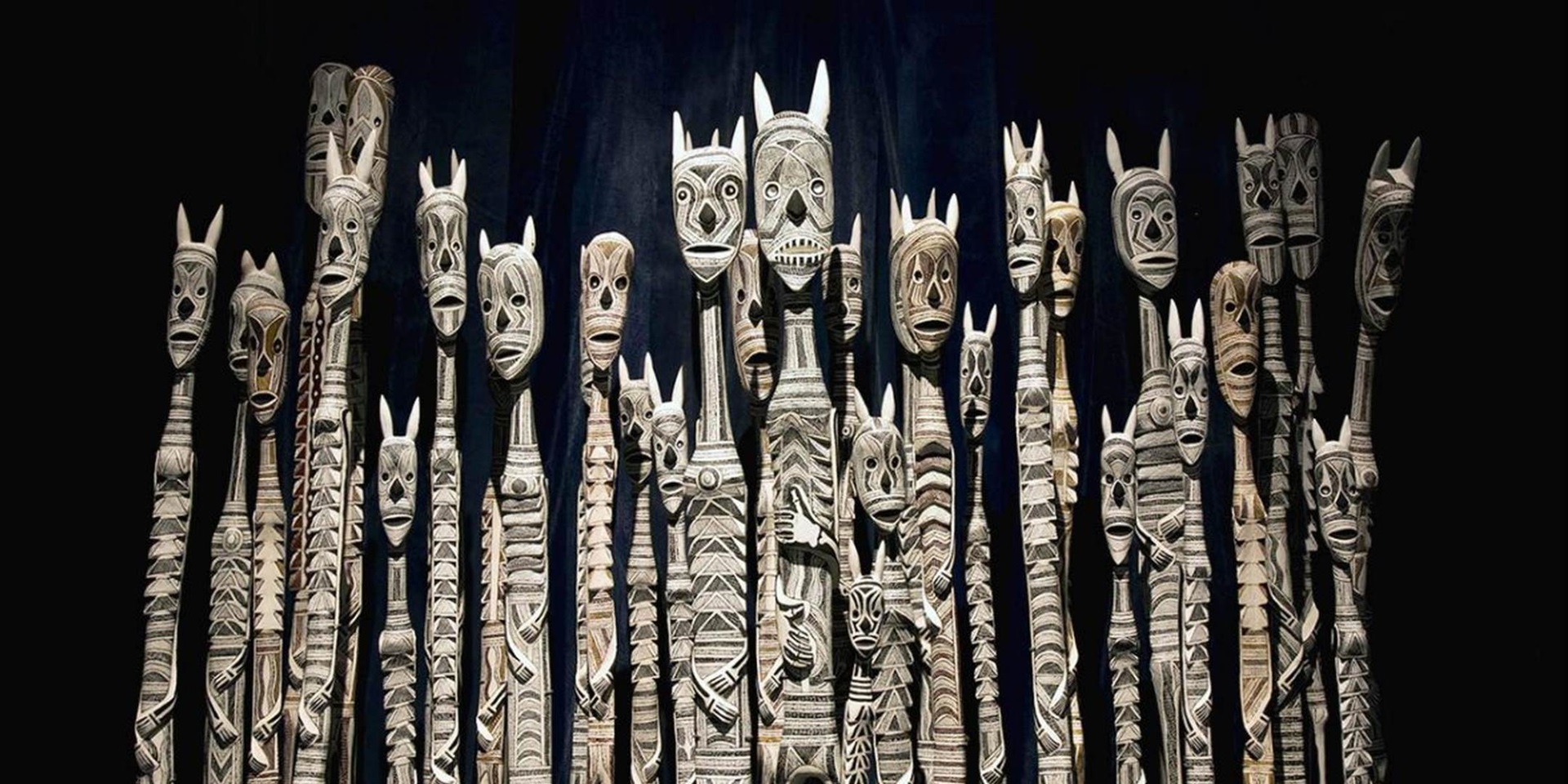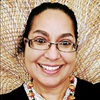
In 2015 the museum purchased new works titled Mokuy by Yolŋu artist Nawurapu Wunuŋmurra.
The acquisition comprised 36 carved wooden figures produced at the Buku-Larrŋgay Mulka Art Centre in Yirrkala north-east Arnhem Land. These contemporary carvings are the artist’s interpretation of the spirit figures known as mokuy. They speak of cycles, comings and goings, life and death and the strong tradition and culture held within Yolŋu customs.
Yolŋu are Aboriginal people from northeast Arnhem Land, Northern Territory. Yolŋu worldview sees every species of plant, animal, fish or bird or any place or person as belonging to one of the two balancing halves of the world, the clans making up the two moieties that define all Yolŋu relationships to people and country – Yirritja and Dhuwa. The sacred art of this region, known as Miwatj, details the spiritual forces behind the ongoing Creation and the continuing identity of the fresh and saltwater country of the area.
Mokuy is a ghost or the sinister spirit of a deceased person.
Mokuy is a ghost or the sinister spirit of a deceased person. It lives near the burial ground and is believed to harm those who venture too near. These mortuary figures of mokuy made in eastern Arnhem Land are derived from square-sectioned and painted grave-post figures called wuramu. These in turn were influenced by the grave posts of the Makassans, traders from Sulawesi in present-day Indonesia, who visited the shores of Arnhem Land for some 400 years up to the beginning of the 20th century.
The artist, Nawurapu Wunuŋmurra, is the eldest son of senior Yirritja moiety elder the late Yaŋgarriny Wunuŋmurra c 1932–2003 who was the first Aboriginal artist to bring a case of copyright infringement – Yanggarrny Wunungmurra v Peter Stripes (1983) to the Federal Court of Australia, unreported, which he won.
One of the 36 carved wooden Mokuy (Spirits) by Nawurapu Wunungmurra, 2015. ANMM Collection 00054657.
In 1997 Yaŋgarriny Wunuŋmurra was the Overall First Prize winner of the National Aboriginal and Torres Strait Islander Art Awards (NATSIAA). Nawurapu was trained in the school of his father from an early age, first assisting him and then, as his own spiritual authority increased, in his own right.
Nawurapu Wunungmurra. Image: Courtesy Buku-Larrŋgay Mulka Centre.
Displayed side-by-side in the current Gapu-Monuk Saltwater exhibition are two bark paintings by both father and son demonstrating the hereditary ownership of areas of land and sea as documented in their paintings.
After his father’s passing, Nawurapu stepped into this senior role with his brothers. His ceremonial responsibilities have required him to move between the homeland centres of the Miwatj region, north-east Arnhem Land and central Arnhem Land. He has lived in Yirrkala, Gurrumurru, Gängan, Gapuwiak and Wandawuy in recent years.
In 2010 following in his father’s footsteps, Nawurapu entered his mixed media work Mokuy in the National Aboriginal and Torres Strait Islander Art Awards. Nawurapu took out first prize in two categories: New Media and People’s Choice. For the judges, the installation was a stand-out piece in an exhibition of works by 96 finalists. The Mokuy spirits appeared to float theatrically in dancing poses just above the floor onto which archival footage of traditional ceremonial dances was projected, as if they were incarnations of dancing spirits illuminated by the spirits of dancers past. As they turned with the air in the room, they gave a sense of watching the viewer’s every move, as if they were trying to communicate.
Mokuy by Nawurapu Wunungmurra . Winner of the Telstra New Media Award in 2010.
Image courtesy Museum and Art Gallery of the Northern Territory.
The artist says of this work:
“These are happy spirits. They are going home. The mokuy [spirits] come in together, Dhuwa and Yirritja to the sacred ground called Balambala, past Gängan, the other side for all the mokuy to get together. The spirits go there and that’s where they make the yidaki [didgeridoo] sound … different sounds for Yirritja and Dhuwa. The Yirritja and Dhuwa play yidaki to call in the mokuy to the same ground Balambala. The Yirritja mokuy come in on the birds, djilawurr [scrub fowl] and bugutj-bugutj [banded fruit dove]. The Dhuwa mokuy they come in from rangi side [saltwater].
Gapu-Monuk Saltwater curators position the 36 Mokuy (spirit) sculptures as a collective for the first time before their installation in their first exhibition. Image: Beau James/ANMM.
In early 2013 Nawurapu’s right leg was amputated below the knee as the result of an injury, but this did not stop him from creating his art. He continues to harvest timber from the bush in remote areas and work with it. Nawurapu is highly regarded as a leading artist of the region and a renowned contemporary carver and storyteller of mokuy.
A language of dance
In the Yolŋu conception of life, the spirit is eternal. We all have a spirit and once our bodies die that spirit’s journey continues. Ceremonies are still practiced that guide and protect the spirit’s journey to the reservoir of souls, particular to that clan identity from which it emerged. Once it is ready it will identify a new set of parents and announce its impending arrival to the families through some occurrence or manifestation in the environment. In this way the cycle continues and repeats endlessly.
The Makassans also entered Yolŋu cosmology. The grief that people feel in death is equated in Yolŋu songs with the sadness felt when the Makassans left north-east Arnhem Land on the south-easterly Dhimurru wind each May/June. The imagery of the setting sun striking the clouds on the horizon and colouring them pink is like the departing spirit and is equated with the red sails of the visitors’ prahus disappearing over the horizon. A life is over. A season is finished. Families are separated. These emotions are in the songs of the Dhalwaŋu people and in the dances shown in the fragment of film.
The footage the artists used in the installation to accompany the mokuy was captured in the 1920s and unearthed from the University of Melbourne Archives in 2009. Its subject could not be identified by the National Film and Sound Archive, so it was sent to The Mulka Project, an archive of Yolŋu cultural knowledge. There its mystique would slowly be revealed by chance in an incredible 83 years after it was recorded.
Buŋgul at Gaṉdiwuy. Video via The Mulka Project.
What had been a silent film without either an obvious story or identifiable individuals caught the eye of artist Nawurapu Wunuŋmurra. He saw the distinct nature of the storytelling as significant of the Yirritja moiety dances. In the footage he identified three very specific dances of his people (Dhalwaŋu clan). In consultation with his community, Nawurapu identified the flickering projection as his ancestors dancing to their choreography.
He pointed out the dances of guluwidjbidj (curlew) being hunted by rifle. He also saw ‘flag raising’ dance actions that are integral in Yirritja moiety funerals, and which equate with a sail being set and the departing Makassan spirit taking its leave. This is testament to the closeness of the relationships over centuries between Yolŋu and Makassans, which were not just economic but intimate and heartfelt.
The oldest surviving black-and-white film of the ceremonial dance Dhalwangu Bunggul, filmmaker unknown. Duration 4:10 (frame 1:32). Reproduced with permission of Buku-Larrŋgay Mulka Arts Centre, Yirrkala, Arnhem Land.
The film’s soundtrack incorporates a single-stringed instrument played with a bow. In Bugis (a language of Sulawesi, Indonesia), it is known as sindrilik. In the third dance depicted in the film, the dancers imitate the playing of the sindrilik using a stick.
These motions, according to Nawurapu, are dances of the ‘foreign people’ (the Makassans), which the Yolŋu would perform in celebratory preparation for the annual return of the Makassan prahu. It seemed clear that the protagonists were performing dances relating to outsiders (Makassans) for the filmmaker, who was also an outsider and whose identity remains unknown. The film title is in the Yolŋu language: Buŋgul at Gaṉdiwuy (dance at Gaṉdiwuy).
So, after almost a century, a formerly unidentifiable fragment of film that appears to pre-date any settled European presences in eastern Arnhem Land is given a name, a connection to place and peoples, and the opportunity for an artist to unravel dimensions to its connections across the seas.
References
- Cover image: Nawurapu Wunuŋmurra’s Mokuy (spirit) sculptures Gapu-Monuk Saltwater Journey to Sea Country, November 2017. Image: Andrew Frolows/ANMM.
- With thanks to Buku-Larrŋgay Mulka Art Centre for their permission to use and share images and cultural descriptions for publication.
- Film Buŋgul at Gaṉdiwuy supplied with permission from The Mulka Project
- Yolŋu Matha means the Yolŋu language. Yolŋu Matha is written using special characters to symbolise certain sounds. When the symbols cannot be written the lettering will appear in full. Some pronunciation examples include: ŋ or Ŋ for 'ng' (as in song) and n or N with your tongue curled back.
Credits
This article originally appeared in the museum’s quarterly magazine Signals number 116 (September-November 2016). You can read more maritime stories in our Signals Magazine.
Notes
- Anthropologist Donald Thomson and mission superintendent Wilbur Chaseling collected sculptures from Yirrkala during the 1930s. Thomson expert, Lindy Allen of Museum Victoria, is certain that it would not have been Donald Thomson who captured this film.
- The museum wishes to thank the Buku-Larrngay Mulka Arts Centre for their permission to use and share images and cultural descriptions for publication.
Sources
- Buku-Larrngay Mulka Arts centre.
- NATSIAA 2010 press coverage.
- Judith Ryan, Senior Curator, Indigenous Art, National Gallery of Victoria, ‘Lipundja and Unknown Yolngu Artist: Mokuy Figures’.

